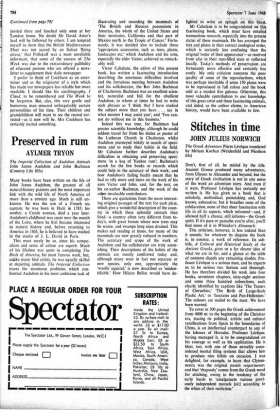Preserved in rum
AYLMER TRYON
The Imperial Collection of Audubon Animals John James Audubon and John Bachman (Country Life 105s)
Many books have been written on the life of John James Audubon, the greatest of all natural-history painters and the most important link with the wild life of North America of more than a century ago. Much is still un- known. He was the son of a French sea captain; he was born in Haiti in 1785; his mother, a Creole woman, died a year later. Audubon's childhood was spent near the mouth of the Loire, where he first became interested in natural history and, before returning to America in 1803, he is believed to have studied in the studio of J. L. David in Paris.
This must surely be so, since his compo- sition and sense of colour are superb. Much of his lifetime was spent in completing The Birds of America, his most famous work, but, unlike many bird artists, he was equally skilful at depicting animals. The Imperial Collection traces the enormous problems which con- fronted Audubon in his most ambitious task of illustrating and recording the mammals of `The British and Russian possessions in America, the whole of the United States and their territories, California and that part of Mexico north to the Tropic of Cancer.' Fortu- nately, it was decided also to include those `appropriate accessories, such as trees, plants, landscapes etc,' which Audubon and his sons, especially the elder Victor, achieved so remark- ably well.
Victor Cahalane, the editor of this present book, has written a fascinating introduction describing the enormous difficulties involved and the fortuitous meeting between Audubon and his collaborator, the Rev John Bachman of Charleston. Bachman was an excellent scien- tist, naturalist and foil for the ebullient Audubon, to whom at times he had to write such phrases as 'I think that I have studied the subject more than you have . . . say in what manner I may assist you'; and 'You can- not do without me in this business.'
Indeed this was true, for Bachman had greater scientific knowledge, although he could seldom travel far from his duties as pastor of the Lutheran Church in Charleston, whilst Audubon journeyed widely in search of speci- mens and to study their habits in the field. Mr Cahalane further describes Audubon's difficulties in obtaining and preserving speci- mens 'in a keg of Yankee rum'; Bachman's search for the few books or records which could help in the accuracy of their work; and how Audubon's failing health meant that he had to rely more and more on the work of his sons Victor and John, and, for the text, on his co-author Bachman, and the work of the other invaluable contributors.
There are quotations from the more interest- ing original passages of the text for each plate, which give a wonderful description of the coun- try in which these splendid animals then lived—a country often very different from to- day's, with great forests where now trees may be scarce, and swamps long since drained. This makes sad reading at times, for many of the mammals are now greatly reduced in numbers. The accuracy and scope of the work of Audubon and his collaborator are truly aston- ishing. Their descriptions of the habits of the animals are mostly confirmed today and, although many were in fact not separate or new species, only one, appropriately the `woolly squirrel,' is now described as 'uniden- tifiable.' How Hilaire Belloc would have de- lighted to write an epitaph on this beast.
Mr Cahalane is to be congratulated on this fascinating book, which must have entailed tremendous research, especially into the present status of these mammals. He has arranged the text and plates in their correct zoological order, which is certainly less confusing than the original 'order of their appearance'—as received from afar in their rum-filled state or collected locally. Today's methods of preservation are fortunately more effective and certainly less costly. My only criticism concerns the poor quality of some of the reproductions, which was perhaps inevitable if some 150 plates were to be reproduced in full colour and the book sold at a modest five guineas. Otherwise, this most valuable contribution to our knowledge of this great artist and these fascinating animals, and inded, as the author claims, to American history, would have been available to few.






































 Previous page
Previous page